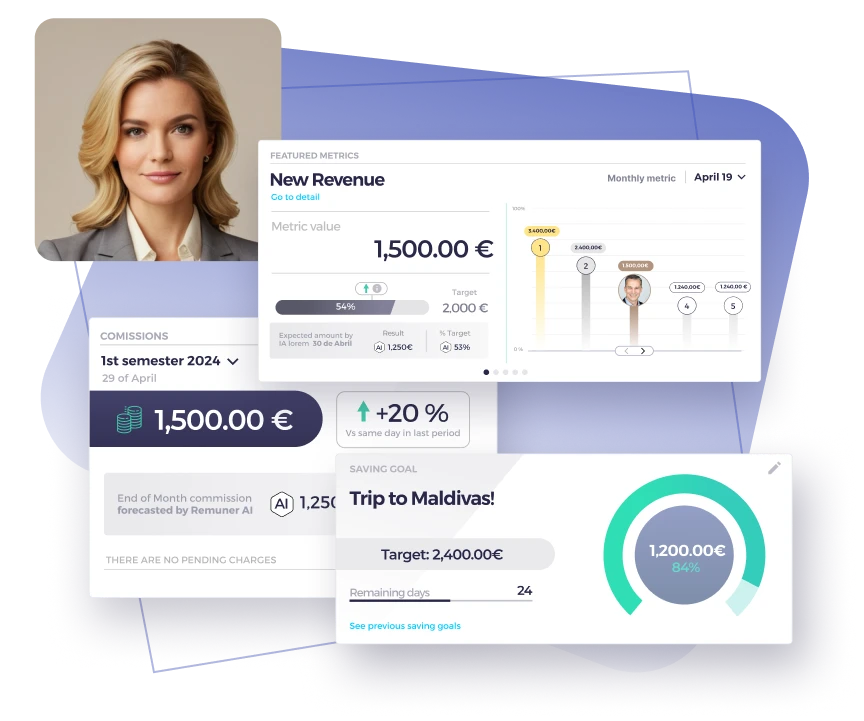Table of contents
Let’s explore the most impactful sales key performance indicators, their relevance, and how to apply them effectively.
1. Total number of deals
Tracking the total number of deals provides a snapshot of your team’s productivity. A high volume of closed deals often correlates with successful sales efforts. However, it’s essential to balance quantity with quality.
Example: A company selling subscription-based products might aim for 100 deals per month, with each deal contributing to their MRR target.
2. Win rate
Your win rate measures the percentage of deals won out of the total opportunities. It highlights the effectiveness of your sales strategy and the efficiency of your sales process.
Formula: Win rate = (Number of closed deals ÷ Total opportunities) × 100
Example: If your team closed 20 deals out of 50 opportunities, the win rate is 40%.
3. Sales pipeline value
The sales pipeline reflects the potential revenue from all active opportunities. Monitoring this value ensures your team is working on deals that align with revenue goals.
Example: A sales manager might set a pipeline target of $1M to align with quarterly quotas.
4. Customer lifetime value (CLV)
CLV measures the total revenue a customer generates over their relationship with your business. It helps businesses prioritize long-term customer relationships over one-time sales.
Example: A SaaS company with a CLV of $10,000 might focus on upselling and cross-selling to increase this value.
5. Monthly recurring revenue (MRR)
MRR is a crucial metric for subscription-based businesses. It reflects the predictable revenue generated each month.
Example: If your company signs 10 new customers paying $500/month, your MRR increases by $5,000.
6. Lead-to-Customer Conversion Rate
The lead-to-customer conversion rate shows how efficiently your team converts leads into paying customers. It reveals the quality of your sales pipeline and the effectiveness of your sales activities.
Formula: Lead-to-Customer Conversion Rate = (Number of new customers ÷ Total leads) × 100
Example:
If you receive 500 qualified leads in a month and convert 50 into paying customers, your conversion rate is 10%. Improving this metric often involves better lead qualification and targeted sales approaches.
7. Sales Cycle Length
The sales cycle length measures the average time it takes to close a deal. Shorter cycles often indicate a well-optimized sales process, while longer cycles may highlight inefficiencies.
Formula:
Sales Cycle Length = Total time taken to close deals ÷ Total number of deals closed
Example:
If the average sales cycle for your product is 30 days, implementing automated follow-ups and streamlining negotiation steps can reduce this time to 25 days.
8. Average Revenue per User (ARPU)
ARPU helps measure the average revenue generated from each customer. This is especially useful for subscription-based businesses.
Formula:
ARPU = Total Revenue ÷ Total Number of Customers
Example:
If your total monthly revenue is $50,000 and you have 500 customers, your ARPU is $100. Increasing ARPU often involves upselling or cross-selling complementary products or services.
9. Upsell and Cross-Sell Revenue
This metric tracks revenue generated from selling additional products or services to existing customers. It’s a critical indicator for companies aiming to maximize customer lifetime value.
Example:
A software company notices that adding advanced analytics features as an upsell increases average purchase value by 20%.
10. Churn Rate
Churn rate measures the percentage of customers who stop doing business with you during a specific period. A high churn rate indicates a need to improve customer satisfaction and retention strategies.
Formula:
Churn Rate = (Number of customers lost ÷ Total customers at the start of the period) × 100
Example:
If you start with 1,000 customers and lose 50 in a month, your churn rate is 5%. Reducing churn by focusing on customer success can significantly impact MRR.

11. Quota Attainment Rate
Quota attainment rate measures the percentage of salespeople meeting or exceeding their sales quotas. It provides insight into the effectiveness of your compensation and incentive structure.
Formula:
Quota Attainment Rate = (Number of reps achieving quota ÷ Total number of reps) × 100
Example:
If 8 out of 10 sales representatives meet their quota, your attainment rate is 80%. Adjusting quotas or providing additional training can help improve this rate.
12. Sales by Region
Tracking sales performance across regions helps identify geographic strengths and areas needing improvement. It also ensures resource allocation aligns with market potential.
Example:
A company notices that sales in Region A are consistently higher than in Region B. This data prompts an investment in additional resources for Region B to boost performance.
13. Customer Acquisition Cost (CAC)
CAC measures the cost of acquiring a new customer, including marketing and sales expenses. Lowering CAC while maintaining sales volume is a sign of efficient sales operations.
Formula:
CAC = Total Sales and Marketing Expenses ÷ Number of New Customers Acquired
Example:
If you spend $20,000 on sales and marketing to acquire 200 customers, your CAC is $100. Improving lead targeting and optimizing sales strategies can help reduce this cost.
14. Sales Opportunity Score
Assigning a score to sales opportunities based on their likelihood of closing helps prioritize high-value deals. This metric can be influenced by factors like deal size, lead quality, and engagement level.
Example:
A sales manager assigns scores from 1 to 10 for all opportunities. Deals with scores of 8 or higher receive immediate attention, improving the overall close rate.
15. Percentage of Repeat Customers
Repeat customers are a key indicator of brand loyalty and satisfaction. A high percentage of repeat customers can reduce acquisition costs and increase overall revenue.
Formula:
Percentage of Repeat Customers = (Number of repeat customers ÷ Total customers) × 100
Example:
If 200 out of 1,000 customers make repeat purchases, your repeat customer rate is 20%. Loyalty programs and excellent customer service can help increase this metric.
16. Revenue Growth Rate
Revenue growth measures the percentage increase (or decrease) in revenue over a specific period. It provides a high-level view of business performance and sales effectiveness.
Formula:
Revenue Growth Rate = [(Current revenue – Previous revenue) ÷ Previous revenue] × 100
Example:
If your monthly revenue grew from $100,000 to $120,000, the growth rate is 20%. This metric often aligns with sales incentives to drive further increases.
17. Cost of Goods Sold (COGS) to Revenue Ratio
This ratio helps determine how efficiently a company generates revenue relative to the cost of delivering products or services. Lower ratios indicate better profitability.
Formula:
COGS to Revenue Ratio = (Cost of Goods Sold ÷ Total Revenue) × 100
Example:
If COGS is $40,000 and total revenue is $100,000, the ratio is 40%. Companies often aim to reduce this ratio without compromising product quality.
18. Sales Call Activity
Tracking the number of sales calls made, meetings scheduled, and demos conducted provides insight into team productivity. These activities often correlate directly with total deals closed.
Example:
A team averaging 50 calls per week might set a goal to increase to 70 calls, expecting a proportional rise in closed deals.
19. Time to First Contact
This metric measures the time it takes for sales teams to respond to a new lead. Shorter response times often lead to higher conversion rates.
Example:
Responding to leads within 5 minutes can double the chances of converting them compared to waiting 24 hours.
20. Sales Velocity
Sales velocity calculates how quickly deals move through the pipeline, providing a comprehensive view of sales efficiency.
Formula:
Sales Velocity = (Number of deals × Average deal size × Win rate) ÷ Sales cycle length
Example:
If a team closes 10 deals worth $5,000 each with a 50% win rate in 30 days, their sales velocity is $833 per day.
How to choose the right sales kpis
Choosing the right kpis depends on your business goals, products or services, and customer base. Follow the SMART framework:
- Specific: Define clear, focused metrics.
- Measurable: Use data to quantify progress.
- Achievable: Set realistic targets.
- Relevant: Align metrics with business objectives.
- Timely: Track performance within a defined timeframe.
Example: A goal to “increase win rate from 40% to 50% within six months” is SMART.
Final thoughts on tracking kpis
Sales key performance indicators are more than numbers; they are tools to drive strategy, align teams, and measure success. By focusing on the right metrics—such as win rate, MRR, and sales pipeline value—companies can refine their sales activities, motivate teams, and achieve sustainable growth.
When combined with thoughtful sales incentives and transparent compensation plans, these kpis create a winning formula for improving sales performance. Start tracking your metrics today and watch your team thrive!





